Hiking
Sacramento Historic Trail
SCOUT OUTINGS
Aviation
Space
Automobiles
Ships & Naval
Trains
Canoeing
Kayaking
Rafting
Sailing
Windsurfing
State
National
County
Regional
Indoor
Rock
Historic
Local
Rim of the Bay
Skyline
Bay Area Ridge
Tahoe Rim
Pacific Crest
Scuba
Stand Up Paddling
Surfing
Swimming
![]() Indicates past or planned
troop outing
Indicates past or planned
troop outing
Sacramento Historic Trail Hike
and Sacramento Historic Rail Hike
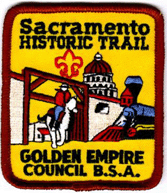
 How
to take the hike
How
to take the hike
1) Railroad Museum (requires admission fee, save ticket stubs)
2) Sacramento History Museum
3) Big Four Building. From the RR Museum, exit to the right. Big Four Building is located and the RR Library and the Hardware store is located within.
4) The earliest Sacramento, a tent city.
5) Central Pacific RR Passenger Station
6) Eagle Theatre. Across the street from the CPRP Station
7) Cobblestone Streets
8) The Globe and the Delta King.
9) Pony Express Rider statue. NE Corner of 2nd and J
10) Sacramento Southern RR. From Front Street, go up K. St. to see the Lady Adams Building. Return to Front St. and you can go to the Visitor’s Center. Continue on Front St. to the Old Schoolhouse Museum on the SW corner of Front and L Streets.
11) Hike down K Street past the Convention Center to the State Indian Museum. Go to L Street to Sutter’s Fort.
12) From Sutter’s Fort, hike down L Street over to the State Capitol and take a self-guided tour.
13) From the State Capitol, hike down Capitol Avenue to 9th Street and head south to N Street. Visit Stanford House (Currently closed for renovations)
14) From Stanford House, head west on N Street and turn left on 3rd Street to Crocker Art Gallery.
15) From the Crocker Art Gallery, hike to SVRR Station and then back to Old Town.
16) Head back up Front Street and under Capitol to Old Town.
17) From Old Town, take the American Discovery trail to Camp Pollock.
![]() Indicates
California Historic Landmarks
Indicates
California Historic Landmarks
Sacramento
Spanish explorers named the area and river in honor of the Holy Sacrament. In 1839, John Sutter arrived in Sacramento and established a permanent settlement. By early 1849, pioneer Sam Brannan had established several permanent buildings west of Sutter's Fort near the waterfront area. The news of the discovery of gold spread quickly, and the streets filled with gold seekers from around the world.
Through the 1850s, the city continued to grow - in spite of the natural calamities that were an intrinsic part of Sacramento's early history. Soon after the first flood, fire swept through the city. In 1862, thousands of cubic yards of earth were brought in on wagons, and the city literally was raised above flood levels.
The Gold Rush of 1849 helped make Sacramento headquarters for some of the most influential men in the Old West. Collis P. Huntington, Charles Crocker, Leland Stanford, and Mark Hopkins - the Big Four - met in a hardware store with Theodore Judah and planned the first transcontinental railroad. The transcontinental telegraph also began in Sacramento.
![]() NO. 812 OLD
SACRAMENTO - Founded in
December 1848 by John A. Sutter, Jr., Sacramento was an outgrowth of
Sutter's Fort established by his father, Captain John A. Sutter, in
1839. State capital since 1854, during the gold rush it was a major
distribution point, a commercial and agricultural center, and terminus
for wagon train, stagecoach, riverboat, telegraph, pony express, and
the first transcontinental railroad.
NO. 812 OLD
SACRAMENTO - Founded in
December 1848 by John A. Sutter, Jr., Sacramento was an outgrowth of
Sutter's Fort established by his father, Captain John A. Sutter, in
1839. State capital since 1854, during the gold rush it was a major
distribution point, a commercial and agricultural center, and terminus
for wagon train, stagecoach, riverboat, telegraph, pony express, and
the first transcontinental railroad.
Location:
Old Sacramento State Historic Park,
plaque located on wall at 2nd St between J and I Sts, Sacramento
California State Railroad Museum
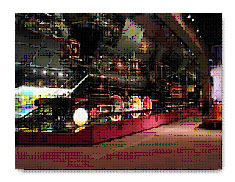 Open
daily from 10AM to 5PM
Open
daily from 10AM to 5PM
The Museum of Railroad History,
a 100,000-square-foot facility housing an unparalleled collection of
locomotives, cars, artifacts, graphics, interpretive exhibits, and
location opportunities.
The locomotive collection of the California State Railroad Museum contains 19 steam locomotives dating from 1862 to 1944. The Museum's locomotives illustrate the development of steam technology from its early years in the mid-nineteenth century through its apogee and climax in the 1940s. The engines range in size from the diminutive Southern Pacific No. 1, "C.P. Huntington," (the Museum's logo locomotive) to the million-pound giant, Southern Pacific articulated cab-forward No. 4294. Fewer than 30 full-size steam locomotives built prior to 1880 exist in the United States. The Museum has five of these, including Central Pacific Railroad locomotive No. 1, "Gov. Stanford."
Admission:
$4 adults; Youths and children ages 16 and under are free.
Sacramento History Museum (Discovery Museum)
The Discovery Museum of Sacramento, housed in an authentic replica of the city's first City Hall and Waterworks Building (originally constructed in 1854). The white wooden structure you see on top of the roof held water tanks that contained more than 200,000 gallons. The water was pumped from the Sacramento River by a steam engine located at the rear of the building. The water traveled down black pipes, where it connected to hydrants and water outlets throughout the city.
Big Four Building
The combined Huntington, Hopkins &
Company
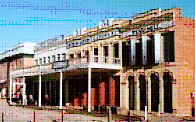 Hardware
Store and Stanford Brothers Warehouse, which together comprise the
"Big Four Building," and the adjacent Nathaniel Dingley Steam Coffee &
Spice Mill building play important roles in showcasing Sacramento’s
early railroad and commercial heritage.
Hardware
Store and Stanford Brothers Warehouse, which together comprise the
"Big Four Building," and the adjacent Nathaniel Dingley Steam Coffee &
Spice Mill building play important roles in showcasing Sacramento’s
early railroad and commercial heritage.
At first the second floor spaces were occupied as living quarters by the Huntington and Hopkins families. But as both businessmen became more prosperous and were able to build homes in residential areas, the upper floor of the Huntington, Hopkins & Company side was used as a stockroom and as lodging for the store’s clerks. Most important among the Stanford side’s upstairs tenants was the Central Pacific Railroad, established by Charles Crocker, Huntington, Hopkins, and Stanford. The Big Four Building would serve as the railroad’s first headquarters, throughout the challenging years of construction and into the first decade of transcontinental operations.
Central Pacific RR Passenger Station
The Central Pacific Railroad Passenger Station is a faithful reconstruction of the western terminus of America's first transcontinental railroad as it appeared around 1876.
 Eagle
Theater
Eagle
Theater
The Eagle Theatre is a reconstruction of the first building erected in California as a theater. The original playhouse, built of wood frame and canvas, with a tin roof, provided Gold Rush Sacramentans with entertainment for a mere three months before being inundated in the flood of January 4, 1850.
![]() NO.
595 EAGLE
THEATER - This is the site
of the first building in California constructed as a
theater in 1849. The theater was reconstructed in 1974.
NO.
595 EAGLE
THEATER - This is the site
of the first building in California constructed as a
theater in 1849. The theater was reconstructed in 1974.
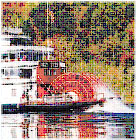 The
Globe and the Delta King
The
Globe and the Delta King
The Delta King ran between Sacramento and San Francisco from 1927 to 1930, a 10 hour trip each way. After it was retired they shipped the Delta King between Canada and California trying to find a permanent home. The Delta King even sunk once in 1984. Finally in 1989 the Delta King made it's home in Old Sacramento on the restored water front. The Delta King serves as a hotel with a saloon, restaurant, and a theater.
Pony Express Rider
In
1860, Russell, Majors, and Waddell formed the Central Overland
California
and Pike's Peak Express Company for Pony Express operations, to show
that mail could be carried year round over the
Central Route
to California.
The Pony Express was an efficient mail service, but it failed as a
profitable enterprise. It is not known exactly how much the service
cost Russell, but during its operation the company only grossed
$90,141, or about the cost of purchasing horses for the service. By
all accounts the Pony Express had lost $200,000 by the time it closed
operations.
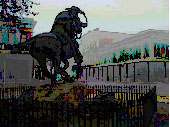
Although the Pony Express lasted only 18 months, it came to symbolize swift service, the spirit of adventure, faithful execution of a very exacting and dangerous task, and heroic endurance
The Mochila. Although mail had been delivered by horse before, it was the mochila (Sp. knapsack) that made the Pony Express stand out. It was a rectangular leather blanket of sorts that fit securely over a McClelland saddle. It had four cantinas (pockets) in the four corners that carried mail and were each padlocked.
The design allowed for easy and quick removal and placement on a fresh horse at Remount Stations. The rider's weight kept the mochila in place during the rugged rides. The total weight of the mochila, saddle and bridle was 13 pounds.
Sacramento Southern RR
 The
Sacramento Southern was totally owned, funded, and operated by SP, the
standard-gauge line was to be built in a southeasterly direction from
Sacramento to Stockton. Plans called for the railroad to be 100 miles
long, to serve as a common carrier for both freight and passengers,
and to have two branches—one running from Walnut Grove to the vicinity
of Antioch, the other connecting Woodbridge with the SP main line.
Although the Sacramento Southern never became more than a branch
“feeder” line, SP had its reasons for these plans. At the time, the
railroad was seeking an alternate passenger route from Sacramento to
San Francisco Bay; its main line to Benicia was sinking into the
Suisun Bay marshlands, and the SP was unsure it could control the
problem.
The
Sacramento Southern was totally owned, funded, and operated by SP, the
standard-gauge line was to be built in a southeasterly direction from
Sacramento to Stockton. Plans called for the railroad to be 100 miles
long, to serve as a common carrier for both freight and passengers,
and to have two branches—one running from Walnut Grove to the vicinity
of Antioch, the other connecting Woodbridge with the SP main line.
Although the Sacramento Southern never became more than a branch
“feeder” line, SP had its reasons for these plans. At the time, the
railroad was seeking an alternate passenger route from Sacramento to
San Francisco Bay; its main line to Benicia was sinking into the
Suisun Bay marshlands, and the SP was unsure it could control the
problem.
NO. 366 PIONEER TELEGRAPH STATION - his was the location of the office occupied by the State Telegraph Company, 1863-1868, and the Western Union Telegraph Company, 1868-1915.
BF Hastings Building
 When
Sacramento became California's capital in 1854, the state's Supreme
Court took space in the Hastings Building (beginning in February
1855). In 1857 the Court moved to the Jansen Building at Fourth and J
Streets, but returned to its original location in the Hastings
Building in December of 1859. It stayed there until 1869, when its new
quarters were ready in the State Capitol.
When
Sacramento became California's capital in 1854, the state's Supreme
Court took space in the Hastings Building (beginning in February
1855). In 1857 the Court moved to the Jansen Building at Fourth and J
Streets, but returned to its original location in the Hastings
Building in December of 1859. It stayed there until 1869, when its new
quarters were ready in the State Capitol.
On December 3, 1869, the California Supreme Court heard its first case
in the new Capitol and a significant chapter in the life of the B. F.
Hastings Building came to a close. The B. F. Hastings Building was
officially dedicated as a unit of the California Department of Parks
and Recreation on March 17, 1976.
Today, the first floor of the B. F. Hastings Building houses the Wells
Fargo History Museum, along with changing exhibits from the Towe Auto
Museum.
![]() NO.
606 B.
F. HASTINGS BUILDING - This
structure, erected in 1852-53, was occupied during the 1850s by the B.
F. Hastings Bank, Wells Fargo & Co., various state officials, the
Sacramento Valley Railroad, and the Alta Telegraph Co. During April
1860-May 1861, the Alta Telegraph Co. and its successor, the
California State Telegraph Co., were the agents here for the Central
Overland Pony Express, owned and operated by the firm of Russell,
Majors, and Waddell. The first overland journey eastward of the Pony
Express was begun from this historic site on April 4, 1860.
NO.
606 B.
F. HASTINGS BUILDING - This
structure, erected in 1852-53, was occupied during the 1850s by the B.
F. Hastings Bank, Wells Fargo & Co., various state officials, the
Sacramento Valley Railroad, and the Alta Telegraph Co. During April
1860-May 1861, the Alta Telegraph Co. and its successor, the
California State Telegraph Co., were the agents here for the Central
Overland Pony Express, owned and operated by the firm of Russell,
Majors, and Waddell. The first overland journey eastward of the Pony
Express was begun from this historic site on April 4, 1860.
Lady Adams Building
A devastating fire in 1852 demolished Sacramento; only the Lady Adams Co. building on K Street, made of brick with a roof reinforced by tin and sand, was left standing. Today, it is the oldest structure in Sacramento. The store and office building was erected in 1852 from materials brought around the Horn in the ship Lady Adams.
State Indian Museum
This museum offers a multimedia view of American Indian life in California. The museum has arts and crafts exhibits, the replica of a village, and a 10-minute video that details the life of American Indians in California. The museum, located at 2618 K St., is open every day except on Thanksgiving, Christmas, and New Year’s Day. Call (916) 324-0971 to get more information. Self-guided tours provide an opportunity to celebrate the proud heritage of California Indian culture from the traditions of the ancestors to contemporary Native artists. Special events include Ishi Day, Acorn Day, and Gathering of Honored Elders in addition to an exhibit showcasing the effects of the Gold Rush on Native Californians.
Admission:
$4 adults; Youths and children ages 16 and under are free.
![]() NO. 991 STATE
INDIAN MUSEUM - The State Indian Museum was built fifty
years ago as California's first state-run museum devoted to Indian
cultures. It continues to serve the same purpose today, displaying an
updated (1984) major exhibit on California's Indian peoples.
NO. 991 STATE
INDIAN MUSEUM - The State Indian Museum was built fifty
years ago as California's first state-run museum devoted to Indian
cultures. It continues to serve the same purpose today, displaying an
updated (1984) major exhibit on California's Indian peoples.
Location:
2618 'K' St, Sacramento
Sutter's Fort SHP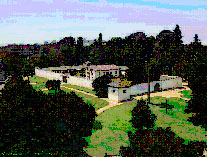
2710 L Street
Open daily from 10:00 AM to 5:00 PM
 The
"Fort" built by immigrant John Sutter more than 150 years ago was not
only located at a pivotal point in California. It was a pivotal point
in history. This combination of big dreams, bold adventures and
reality all manifest themselves at Sutter's Fort State Historic Park
and help bring California history to life.
The
"Fort" built by immigrant John Sutter more than 150 years ago was not
only located at a pivotal point in California. It was a pivotal point
in history. This combination of big dreams, bold adventures and
reality all manifest themselves at Sutter's Fort State Historic Park
and help bring California history to life.
Sutter made it to California and arrived in Sacramento in the late fall of 1839. In Sacramento, he built what came to be know as Sutter's Fort -- with walls that were 2 1/2 feet thick and 15 to 18 feet high -- and developed what he considered to be the real wealth of California -- crops such as grapes and wheat, along with vast herds of cattle.
Aligning himself with the Mexican authorities, at one point, with his various land grants, Sutter owned more than 150,000 acres of the Central Valley, and was a generous host to such colorful and historically important characters as John C. Fremont and Kit Carson.
In 1848, James Marshall, a carpenter working for Sutter, discovered gold at the sawmill Sutter was having built in Coloma, on the American River. Before the mill could be finished, word of the discovery was out. Sutter's workers deserted the Fort for the goldfields seeking their fortunes. By the 1850's, all that was left of Sutter's Fort was the central building.
$2 adults for those 13 and over; $1 for children 6 to 12
![]() NO.
525 SUTTER'S
FORT - John Augustus Sutter,
born of Swiss parents, arrived in New York in July 1834 and in
California in July 1839. He founded the fort in 1839 to protect 'New
Helvetia,' his 76-square-mile Mexican land grant. Of the original
fort, the two-story central building, made of adobe and oak, remains,
the fort's outer walls and rooms, which had disappeared by the 1860s,
were reconstructed after the State acquired the property in 1890.
NO.
525 SUTTER'S
FORT - John Augustus Sutter,
born of Swiss parents, arrived in New York in July 1834 and in
California in July 1839. He founded the fort in 1839 to protect 'New
Helvetia,' his 76-square-mile Mexican land grant. Of the original
fort, the two-story central building, made of adobe and oak, remains,
the fort's outer walls and rooms, which had disappeared by the 1860s,
were reconstructed after the State acquired the property in 1890.
State
Capitol
The Capitol has a 120-foot-high rotunda, beautifully decorated rooms, and flower gardens and memorials. California's State Capitol was built in the Renaissance Revival style, reminiscent of the U.S. Capitol in Washington D.C. The Capitol's granite base has color variations because the stone initially used, excavated from a quarry near Folsom, was found to be too coarse. A new quarry was selected, though the granite was several shades lighter. The building was finally completed in 1874 at a cost of $2.4 million. The bronze state seal in front of the west entrance was fashioned by San Quentin State Prison inmates. NOTE: Visiting the capitol is one of the requirements for Citizenship in the Community.
Stanford House
 The
Stanford House was built between 1856 and 1857 as a two-story home for
merchant Shelton Fogus, it was purchased by Central Pacific Railroad
co-founder and President, Leland Stanford, in 1861 just before he
became California’s eighth governor.
The
Stanford House was built between 1856 and 1857 as a two-story home for
merchant Shelton Fogus, it was purchased by Central Pacific Railroad
co-founder and President, Leland Stanford, in 1861 just before he
became California’s eighth governor.
Stanford added a separate governor’s office, and later expanded the home to four stories and 19,000 square feet to better meet the needs of his expanded family and enhanced stature. His son, in whose memory Stanford University would be founded, was born in the home in 1868. The mansion is currently closed for renovations.
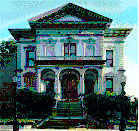 Crocker
Art Museum
Crocker
Art Museum
Third and O Street
Open Tuesday through Sunday, 10AM– 5PM
This museum’s collection
includes 19th- and 20th-century California art, European art, old
master drawings, Indian and Persian miniature paintings, Asian
ceramics and decorative arts, Victorian decorative arts, and a
photography collection. Built as a cultural and entertainment center
in the 1870s, the museum is well loved for its elegant Victorian
architecture.
![]() NO.
599 E.
B. CROCKER ART GALLERY - This
building was erected in 1870 to house the private art collection of
Judge and Mrs. E. B. Crocker. The building and its contents were
donated to the City of Sacramento in 1884 by Mrs. Crocker.
Location:
216 O St, Sacramento
NO.
599 E.
B. CROCKER ART GALLERY - This
building was erected in 1870 to house the private art collection of
Judge and Mrs. E. B. Crocker. The building and its contents were
donated to the City of Sacramento in 1884 by Mrs. Crocker.
Location:
216 O St, Sacramento
Other spots in Old Town
Old Sacramento Schoolhouse
Front and L Street
(916) 483-8818
An authentic one-room schoolhouse.
California History Museum
Investigate the historical aspects of gold. The Lure of Gold is an immersive hands-on exhibit, featuring multi-media stations and a large collection of gold specimens, that chronicles:
-
History's Quest for Gold
-
California's Gold Rush
-
Mining for Gold
"G" Scale Locomotives and Model Train Exhibit
All featured locomotives are "G" scale replicas. These models are
highly detailed and feature the latest in digital sound technology.
The Pony Express Riders
The Discovery Museum will have on exhibit "The Riders of the Pony
Express. At a time when there were no telephones, radios, or
telegraph, letters from New York
to San Francisco took 30 days by steamship around South America. An overland mail route by Butterfield
Express took 23 days for delivery.
Sacramento’s Buried Past
Displayed beneath the beautiful glass floor in the Central Gallery, visitors will walk through time as they study historical artifacts and objects that bring to life our eclectic past.
Admission:
$5.00 - Adults (Age 18+)
$4.00 - Youth (Age 13-17)
$3.00 - Children (Age 4-12)
California Military Museum
Open daily
except Monday from 10:00 to 4:30 p.m.
An interpretive museum with authentic clothing, equipment and stories
from our nation's rich military past.
General Admission: $3.00
Senior Citizens (Over 55): $1.50
Children (10-17): $1.00
Military and Dependents with ID Card: $1.00
Children under 10: FREE!
Wells Fargo Museum
Corner of Second
and J Streets
(916) 440-4263
Open daily.
Stagecoaches, gold, mining, business, commerce are all colorfully
interpreted for visitor
Free Admission.
Sacramento Historic
Train Trail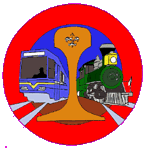
Requirements
Hike the trail as shown on the map, from the Railroad Museum in Old Sacramento to the 13th Street Station and take Light Rail to the Butterfield Station.
Review city hiking rules in the Scout Handbook.
Visit the California State Railroad Museum.
File a report with the Golden Empire Council, listing the names of the Scouts and Scouters who completed the hike.
How to take the hike
1) California State Railroad Museum, 125 I St. (We will have visited the Railroad Museum on Saturday) From Camp Pollock, we’ll take the light rail to the Butterfield-bound Light Rail.
2) 17th Street. On August 17, 1855, 200 people were taken on the first SVRR excursion, as far as 17th Street. John Sutter chose to walk home from 17th Street, having enough of the new mode of transit.
3) Brighton. The town of Brighton was started in 1849 on the south bank of the American River. It was later moved to the intersection of the SVRR and Central Pacific lines (which cross here.) The Brighton Station was the first outside of Sacramento. All that’s left of Brighton today is Brighton Avenue, an industrial street that parallels the track on the south.
4) Butterfield Station is the end of the light rail line. This is near where Patterson’s Station was on the SVRR. A.P. Patterson built American Fork House or Ten Mile House in 1849. The SVRR make its first money by transporting soldiers here on November 10, 1855; the sum was $50. Later, Patterson left and the station was renamed Mayhew for its agent. Mayhew Road is just west of the Butterfield Station.
5) Take the return train back to the closest station near Amtrak.